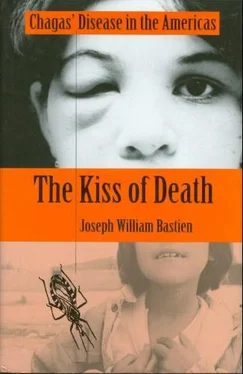What gives credibility to anthropologists’ interpretations is their fieldwork and their data. The following explains some of the reasons why I argue throughout this book for an understanding of Andean ethnomedicine and a culturally sensitive approach to Chagas’ control in Bolivia. This book results from thirty-four years of experience, research, and fieldwork in Bolivia, beginning in 1963 when I first arrived as a Maryknoll priest and worked for six years among the Aymaras of the Altiplano (a plateau 12,500 feet high). I learned the Aymara and Spanish languages. After certain misgivings about missionization, I left the priesthood in 1969 and studied anthropology and the Quechua language at Cornell University to learn about Andean culture. In 1971 I married Judy Wagner and we returned to Bolivia to live with the Kallawaya people, only this time to participate in their rituals and to study how Andean religion has enabled these people to adapt to sickness. Their rituals were symbolic and spiritual processes of dealing with Western diseases (typhoid fever, septicemia, and heart disease) and cultural illnesses (chullpa usu, liquichado, cólico miserere), to name a few. This resulted in my first book, Mountain of the Condor: Metaphor and Ritual in an Andean Ayllu (Bastien 1978). I had become aware of the importance of Andean rituals in the society’s health maintenance and that the biology of disease is perceived differently by these people.
I next studied Kallawaya herbalists to learn about their uses of medicinal plants and how these could be used with biomedicine. Kallawayas employ about a thousand medicinal plants and are renowned throughout Argentina, Bolivia, Peru, and Chile as very skilled herbalists. This research resulted in Healers of the Andes: Kallawaya Herbalists and Their Medicinal Plants (Bastien 1987). I published an herbal manual in Spanish for peasants that was used for training community health workers in the Department of Oruro, Bolivia (Bastien 1983). I returned to Bolivia almost every year to do research. [1] 1. This research is summarized in the following articles and books: concerning Aymara rituals (Bastien 1989), Kallawaya herbal curing (Bastien 1982, 1983a, 1983b), ethnophysiology (Bastien 1985), Kallawaya herbalists (Bastien 1987), cultural perceptions of neonatal tetanus and programming implications (Bastien 1988), integration of ethnomedicine and biomedicine (Bastien 1992), and training of community health workers (Bastien 1990).
By 1980, I again felt the missionary’s impulse, not to evangelize but to argue for the inclusion of Andean traditional medicine, especially herbal medicines, rituals, and curanderos, into national and international health programs. I became an advisor to the National Secretariat of Health and the United States Agency of International Development on the integration of ethnomedicine and community health workers into primary health care programs. [2] 2. Some of these positions were coordinator with Project Concern for community health workers and biomedical personnel of the Department of Oruro, Bolivia, (Bastien 1987b, 1990a); educator with Project Concern for diarrhea control and oral rehydration therapy (Bastien 1987a: 81-84); researcher with Resources for Child Health concerning prevention of neonatal tetanus (Bastien 1988); anthropologist working with Bolivian radio schools (1990); and ethnologist advisor to USAID projects: Community and Child Health (1987a, 1991), Bolivian Forestation Project (1995), and Chagas Control Project, Bolivia (1991).
A more recent endeavor to integrate both types of medicine has been my collaborative research with chemists and pathologists in the testing of Kallawaya-Bolivian medicinal plants for curing AIDS, cancer, Chagas’ disease, and tuberculosis. The results are significant, with certain plants being protease inhibitors for AIDS, and others curing cancer and tuberculosis (Bastien et al. 1990, 1994, 1996). Kallawaya plant medicines also show promise as cures for Chagas’ disease. Scientists at the University of Antofagasta, Chile, are examining these plants.
Bolivian and international health personnel are beginning to integrate ethnomedicine and biomedicine in Bolivia, as I discuss in Drum and Stethoscope: Integrating Ethnomedicine and Biomedicine in Bolivia (Bastien 1992). Doctors, nurses, and project workers work with shamans, midwives, and community health workers in joint clinics. Associations of community health workers, midwives, and herbalists negotiate with doctors and nurses. The National Secretariat of Health coordinates both types of medicine, including providing staffed positions in ethnomedicine. State-run pharmacies stock and sell herbal medicines. This recognition and respect of Andean traditional medicine is encouraging; however, the current hegemony of biomedical medicine, propelled by pharmaceutical and insurance companies, medical associations, and privatization, essentially pits capitalist entrepreneurs against ethnic curanderos and shamans in what becomes for the latter a losing battle.
Kiss of Death’s call for activism is unusual in a scholarly text, but I feel it is appropriate if it helps lead to the creation of prevention programs. Western medical ethics has come to address the manner of distributing resources that affect the maintenance or restoration of health as a moral problem (see Lieban 1990:227). The pattern of allocating resources basic to health and survival raises serious ethical issues in light of the principle of distributive justice, defined as “the justified distribution of benefits and burdens in society” (Beauchamp and Childress 1983:184). Does distribution of resources for combatting Chagas’ disease involve a conflict between the perceived higher valuation of certain communities over others, males over females, adults over children, and wealthier countries over poorer countries?
Because Chagas’ control projects are expensive and involve only a small percentage of communities in Bolivia, an evaluation of their effectiveness as pilot projects is important. For this reason, I concentrate on two pilot projects in the Departments of Chuquisaca and Tarija. The Proyecto Británico-Cardenal Mauer (PBCM) project in the Department of Chuquisaca was considered a successful Chagas’ control project in 1991 by the National Chagas’ Control Committee, which recommended it as a model for other projects throughout Bolivia. It provided a primary health care infrastructure into which Chagas’ control was included. Ruth Sensano organized this infrastructure. The Tarija project stands out for its education of the local populace about Chagas’ disease. José Beltran is the leading educator in this project. Sensano and Beltran are highlighted in these projects because they illustrate what individual Bolivians are doing. These projects serve to help create an improved model that reaches more people more economically and within the cultural context of the community.
I observed other projects, which were heavily funded, hastily done, and had limited effect on Chagas’ control. These projects concentrated on new houses and insecticides, measures that are not affordable and sustainable over time. Insecticides have become too expensive for most communities without government subsidies, which have been discontinued. The pilot nature of these projects failed because they never presented a model to follow. This book assesses the justice of the allocation of health resources in regard to Chagas’ disease. Moreover, it suggests alternative solutions to the problem of providing more people with the means to prevent Chagas’ disease.
Personal Awareness of Chagas’ Disease
Chagas’ disease first became a major health concern in Bolivia in 1991. Until then, it had been a “silent killer” of millions of Bolivians. After twenty years of fieldwork, I first learned about the disease in 1984 when a doctor/epidemiologist and I were visiting Cocapata, a Quechua community, located between snow-crested mountains to the west and the Amazon to the east. We lodged in a peasant’s hut of adobe and thatch and slept on llama skins covering the dirt floor. Even though insects bit me, I slept through the night. As the sun came through the tiny window, I arose and asked my companion how he slept.
Читать дальше












